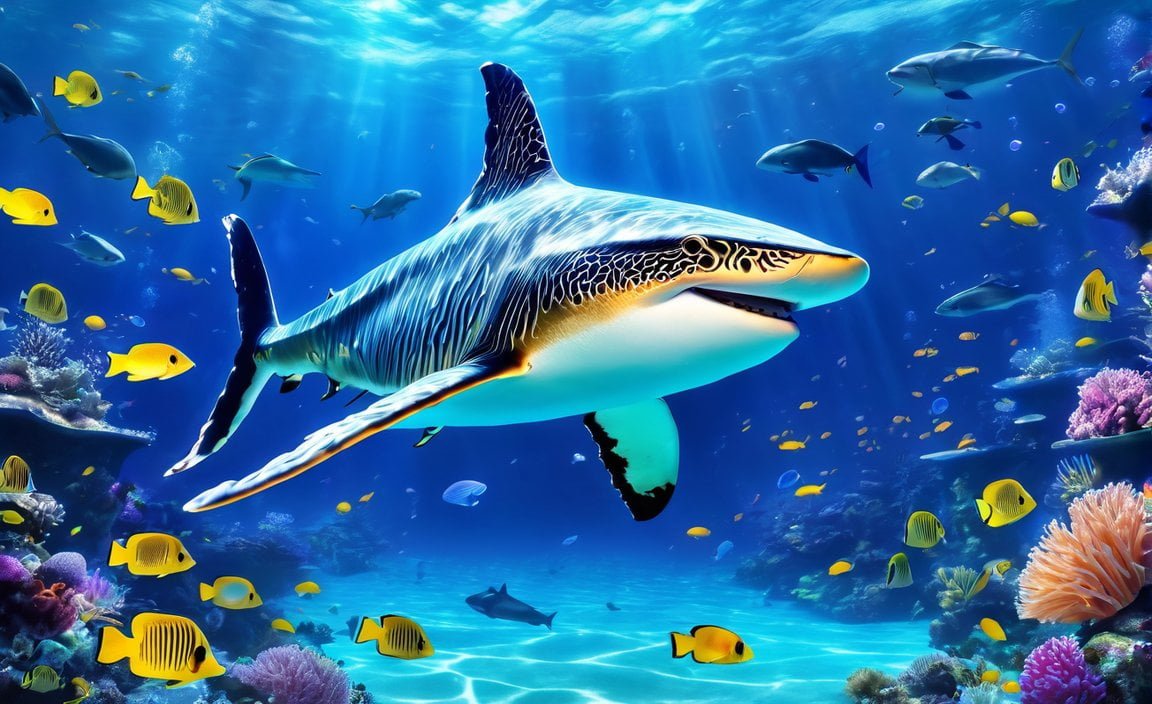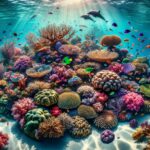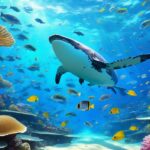Discover Fascinating Facts: 10 Intriguing Traits of Underwater Animals. Prepare to be enthralled as we dive deep into the mesmerizing world of underwater animals. From the mysterious depths of the ocean to the vibrant coral reefs, these incredible creatures possess an array of captivating traits that defy imagination. Join us as we uncover the hidden secrets of their behaviors and adaptations, revealing the astonishing diversity and resilience that exists beneath the waves. Get ready to explore the extraordinary lives of underwater animals and be amazed by the incredible wonders that await!
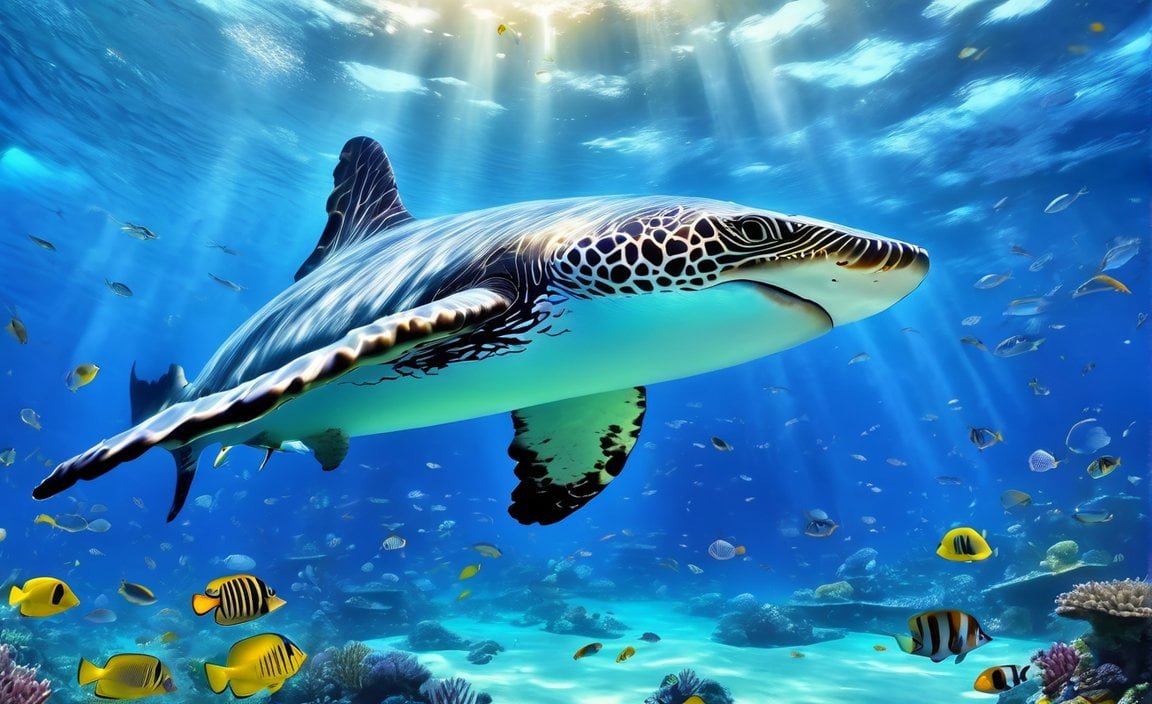
Key Takeaways:
- There are approximately one million species of animals living in the ocean, with the majority being invertebrates.
- The blue whale holds the title for being the largest ocean animal.
- Whale songs can be heard for hundreds of miles in the ocean.
- Many bony fish have more than one set of nostrils.
- Octopuses have three hearts.
- Sea turtles exhibit a remarkable behavior by returning to the same beach where they were born to lay their eggs.
- Sharks have a unique skeletal system made of cartilage instead of bones.
- Damselfish engage in farming little algae gardens.
- Dolphins possess the ability to sleep with one eye open.
- Not all hermit crabs rely on discarded seashells as their portable shelters.
10 Interesting Facts about Underwater Animals
Dive into the mesmerizing world beneath the waves and uncover fascinating facts about the incredible creatures that inhabit our oceans. From the mysterious octopus to the majestic blue whale, the underwater realm is full of astonishing adaptations and behaviors that will leave you in awe. Let’s explore ten intriguing traits of underwater animals that will ignite your curiosity and deepen your appreciation for these remarkable beings.
1. Invertebrates Dominate the Ocean
Did you know that the ocean is home to approximately one million species of animals? And the majority of these creatures are invertebrates – animals without a backbone or spinal column. From delicate corals to intricate seastars, these diverse and often colorful species play a crucial role in maintaining the balance of aquatic ecosystems.
2. The Blue Whale: Giant in the Depths
When it comes to the largest animal living in the ocean, nothing compares to the blue whale. These magnificent giants can reach lengths of up to 100 feet and weigh as much as 200 tons. To put it into perspective, their tongues alone can weigh as much as an elephant!
3. Whale Songs: A Melody Across Miles
Imagine hearing a song that can travel for hundreds of miles underwater. Well, that’s exactly what whale songs are capable of! These hauntingly beautiful melodies are used by whales for communication, attracting mates, and navigating the vast ocean depths. So, the next time you find yourself near the coast, you might just be lucky enough to catch a glimpse of this enchanting concert.
4. Extra Nostrils: Bony Fish Know Better
We often associate nostrils with mammals, but did you know that many bony fish also possess multiple sets of nostrils? These extra nostrils act as a backup system, enabling fish to detect smells even when their primary nostrils may be blocked or damaged. It’s a fishy adaptation that helps them survive in their watery world.
5. Three Hearts and Houdini-like Skills: The Octopus
Prepare to be amazed by the octopus, a master of disguise and ingenuity. Not only do these cephalopods possess remarkable intelligence, but they also have three hearts! Two of these hearts are dedicated to pumping oxygenated blood to the gills, while the other one pumps blood throughout the body. With their mesmerizing ability to change colors and camouflage seamlessly, octopuses are true underwater artists.
6. Homecoming of the Sea Turtles
There’s something truly heartwarming about the journey of sea turtles. When it’s time for these remarkable creatures to lay their eggs, they return to the same beach where they were born. Despite the incredible distances they may have traveled, sea turtles use their internal compass and mysterious navigational abilities to find their way back home. It’s nature’s way of ensuring the survival of their species.
7. Sharks: A Skeleton of Cartilage
While most animals rely on bones to provide structural support and protect vital organs, sharks have a skeletal system made primarily of cartilage. This flexible and lightweight structure allows sharks to navigate with ease and maneuver effortlessly through the water. It’s no wonder they are such efficient predators, equipped with an evolutionary design that has stood the test of time.
8. Underwater Gardeners: Damselfish
Did you know that some damselfish are the green thumbs of the underwater world? These industrious creatures create little algae gardens by aggressively maintaining a specific patch of algae on rocks or coral. By preventing other algae from growing and maintaining a healthy balance, damselfish ensure a steady food supply for themselves and their offspring. It’s a display of underwater horticulture like no other.
9. Sleep with One Eye Open: Dolphins
Ever wondered how dolphins manage to sleep and stay aware of their surroundings at the same time? Well, these intelligent mammals have mastered the art of sleeping with one eye open. To rest, only half of their brain goes to sleep, while the other half remains awake, keeping a watchful eye for potential predators. It’s a clever adaptation that allows dolphins to rest and stay safe in the vast ocean.
10. Hermit Crabs: Finding Creative Shelters
When it comes to finding a portable shelter, hermit crabs are experts at thinking outside of the shell. While most hermit crabs rely on discarded seashells to protect their soft bodies, some species have taken an unconventional approach. These innovative crabs have developed a symbiotic relationship with sea anemones, using them as living shelters. The stinging tentacles of the anemones offer protection, and in return, the crabs provide food scraps. It’s an unlikely alliance that demonstrates the resourcefulness of underwater animals.
Now, armed with these ten interesting facts about underwater animals, you are better equipped to appreciate the marvels of marine life. From the extraordinary adaptations to the fascinating behaviors, the underwater world holds countless wonders just waiting to be discovered. So, dive in and explore the enchanting realm beneath the waves!
Here are some fascinating facts about different biomes that will amaze you:
10 interesting facts about temperate deciduous forest biome: Did you know that temperate deciduous forests are home to the largest land mammal in North America? Discover more unique facts about this captivating biome.
10 interesting facts about the African savanna biome: Get ready to be amazed by the incredible wildlife and stunning landscapes of the African savanna. Learn about the fascinating facts that make this biome truly remarkable.
10 interesting facts about the savanna: Discover the wonders of the savanna biome, where vast grasslands meet scattered trees, creating a unique and diverse habitat. Uncover intriguing facts about this captivating ecosystem.
10 interesting facts about the savanna biome: Delve into the fascinating world of the savanna biome, where a plethora of species coexist in harmony. Prepare to be astounded by the interesting facts that make this biome extraordinary.
10 interesting facts about the temperate deciduous forest: Step into the enchanting realm of the temperate deciduous forest, where vibrant foliage and diverse wildlife flourish. Explore the captivating facts that make this biome truly remarkable.
10 interesting facts about the tropical savanna biome: Experience the breathtaking beauty and magnificence of the tropical savanna biome. Prepare to be captivated by the fascinating facts that make this biome so extraordinary.
The Unique Reproductive Strategies of Underwater Animals
The world beneath the waves is a treasure trove of fascinating and mysterious creatures. From octopuses to sea horses, underwater animals have evolved incredible reproductive strategies that are as diverse as the species themselves. In this article, we will dive into the intriguing world of underwater animal reproduction and explore some of their unique strategies.
1. Octopuses: A Delicate Dance of Reproduction
When it comes to reproductive strategies, octopuses take on a rather extraordinary approach. The male octopus has a specialized arm, known as a hectocotylus, which it uses to deliver sperm to the female. This arm detaches and fertilizes the female’s eggs, allowing the male to ensure his genetic legacy even after his demise[^1^].
2. Sea Horses: The Ultimate Role Reversal
In the realm of underwater reproduction, sea horses stand out with their fascinating approach. Unlike most animal species, it is the male sea horse that carries and gives birth to the young. After the female deposits her eggs into a pouch on the male’s abdomen, they are fertilized and develop under the careful watch of their dedicated father[^1^].
3. Kangaroos: The Art of Delayed Development
Kangaroos, while not aquatic animals themselves, also possess a remarkable reproductive strategy worth mentioning. These marsupials have the incredible ability to delay the development of a fertilized embryo until the environment is more suitable for raising the young. This ensures that the kangaroo offspring have the best chance of survival, even in adverse conditions[^1^].
4. Platypus: A Venomous Encounter
The platypus, a unique mammal found in Australia, possesses a reproductive strategy that is truly one-of-a-kind. During mating season, the male platypus has spurs on its hind legs that deliver venom to its competitors. While not directly related to reproduction, this venomous defense mechanism plays a role in securing a mate and ensuring successful mating opportunities[^1^].
5. Sharks: Withstanding the Test of Time
Female sharks have evolved a reproductive strategy that allows them to store sperm for extended periods of time. This remarkable ability enables them to delay fertilization until conditions are favorable, ensuring their offspring are born into a suitable environment[^1^].
Underwater animals never cease to amaze with their unique and awe-inspiring reproductive strategies. From the delicate dance of the octopus to the ultimate role reversal of the sea horse, these creatures continue to unveil the wonders of the underwater world and remind us of the incredible diversity of life on our planet.
Key Takeaways:
- Octopuses employ a unique reproductive strategy involving the transfer of sperm through a specialized arm called a hectocotylus[^1^].
- Sea horses showcase the ultimate role reversal, with the male carrying and giving birth to the young after fertilization occurs within a pouch on their abdomen[^1^].
- Kangaroos possess the ability to delay the development of a fertilized embryo until environmental conditions are more favorable[^1^].
- The male platypus utilizes venomous spurs on its hind legs as a defense mechanism during mating season, indirectly affecting mating opportunities[^1^].
- Female sharks can store sperm for extended periods to delay fertilization until conditions are suitable for their offspring[^1^].
For more information on the unique reproductive strategies of underwater animals, please refer to the following sources:
- animallot.com: 20 Animals With Unique Reproductive Strategies
- researchgate.net: Alternative Reproductive Tactics
- springer.com: Reproductive Strategies in Marine Invertebrates and the …
The Astonishing Abilities of Underwater Animals to Navigate and Find Their Way
Underwater animals are truly remarkable creatures that have developed astonishing abilities to navigate and find their way in the vast oceans. From unique survival techniques to sensory adaptations, these animals have evolved to thrive in their aquatic environments. Let’s explore some fascinating facts about the incredible navigational abilities of underwater animals.
1. Sea Slug Elysia chlorotica – Nature’s Photosynthesizer [^1^]
The sea slug Elysia chlorotica possesses a truly remarkable ability – it can photosynthesize its own food using sunlight. This little creature steals chloroplasts from algae and incorporates them into its own cells, enabling it to perform photosynthesis and produce energy. It’s like carrying out a miniaturized version of the process usually associated with plants!
2. Black Swallower Chiasmodon Niger – The Voracious Predator [^1^]
The black swallower, Chiasmodon niger, has an astonishingly large stomach that allows it to engulf prey much larger than itself. This unique adaptation in body shape allows the black swallower to consume prey that is up to 10 times its size. Talk about a bottomless appetite!
3. Planarians – Masters of Regeneration [^1^]
Planarians, a type of freshwater flatworm, possess an exceptional regenerative ability. They can regenerate their entire body from just a small fragment, including their heads. This remarkable skill not only helps in repairing injuries but also aids in reproducing multiple offspring from a single individual.
4. Sea Cucumbers – The Masters of Ejection [^1^]
Sea cucumbers have a fascinating defense mechanism in which they can eject their guts at predators and regrow them later. This incredible ability allows them to escape from potential threats and survive in their ocean habitats. It’s a literal example of leaving one’s guts behind!
5. Hagfish – The Great Escapologists [^1^]
Hagfish, ancient creatures that have been around for 300 million years, have evolved some interesting survival tactics. When threatened, they can tie themselves into knots to escape from predators and even escape from the grip of their own slime. It’s a bizarre but effective escape plan!
6. Lobsters – Masters of Navigation [^2^]
Lobsters are known for their exceptional navigational abilities. They can use various cues, including sensing the Earth’s magnetic field and detecting odors, to navigate and find their way in the vast ocean. This makes them highly efficient in their movements, ensuring they always reach their desired destinations.
7. Aquatic Animals – Navigating by Magnetic Sensitivity [^3^]
Aquatic animals, such as fish, have developed the ability to navigate underwater by sensing the Earth’s magnetic field. This remarkable sense of direction allows them to orient themselves and find their way in their underwater environment. It’s like having an inbuilt compass!
8. The Underwater Breath-Holders – Snakes [^4^]
Some underwater animals, like snakes, have an astonishing ability to hold their breath for extended periods. This unique adaptation allows them to survive underwater and adapt to their aquatic habitats. It’s like having an oxygen tank within their bodies!
9. Animal Navigation – Finding the Way Accurately [^5^]
Animal navigation is a fascinating phenomenon observed in various creatures. Birds, insects, and fish can navigate long distances and precisely reach their destinations without relying on maps or instruments. It’s as if they possess an innate GPS system!
10. Aquatic Animals with Mind-Blowing Superpowers [^6^]
Aquatic animals possess a multitude of incredible superpowers that aid their survival in challenging conditions. From bioluminescence to limb regeneration, camouflage to communication through sound or electrical signals, these animals showcase remarkable adaptations that leave us marveling at their ingenuity.
Key Takeaways:
- Sea slugs like Elysia chlorotica can photosynthesize their own food, stealing chloroplasts from algae.
- The black swallower, Chiasmodon niger, has a unique ability to devour prey much larger than itself.
- Planarians can regenerate their entire body, including their heads, from a small piece.
- Sea cucumbers can eject their guts at predators and regrow them later, enabling their escape.
- Hagfish can tie themselves into knots and escape from predators and their own slippery slime.
- Lobsters exhibit exceptional navigational abilities, using cues like the Earth’s magnetic field and odors.
- Aquatic animals, such as fish, navigate underwater by sensing the Earth’s magnetic field.
- Underwater breath-holders like snakes can survive extended periods underwater by holding their breath.
- Many animals, including birds, insects, and fish, possess remarkable navigation skills, enabling accurate long-distance travel.
- Aquatic animals display a range of superpowers like bioluminescence, limb regeneration, camouflage, and communication through sound or electrical signals.
Sources:
– Listverse
– Just Gotta Dive
The Surprising Intelligence and Problem-Solving Skills of Underwater Animals
When we think of underwater animals, we often imagine fascinating creatures with unique adaptations and behaviors. However, what may surprise many is the astonishing intelligence and problem-solving skills that these animals possess. From dolphins and octopuses to orcas and manta rays, the ocean is teeming with intelligent creatures that continue to fascinate researchers and marine enthusiasts alike.
Dolphins: The Masterminds of the Sea
One of the most well-known examples of underwater intelligence is the dolphin. These remarkable creatures are recognized for their complex behaviors and are considered one of the most intelligent sea creatures. With highly developed brains, dolphins exhibit problem-solving skills and display remarkable cognitive abilities [^1^].
Octopuses: Invertebrates with a Genius Mind
Although invertebrates, octopuses are renowned for their astonishing intelligence. These clever creatures possess advanced problem-solving skills and can outsmart their predators with their quick-thinking abilities. Their ability to change colors and camouflage seamlessly also showcases their remarkable cognitive abilities [^1^].
Orcas: The Brilliant Hunters
Orcas, also known as killer whales, are known for their large brains, which enable them to store memories and quickly assess signals from nerve cells. With their problem-solving skills and complex social behaviors, these intelligent creatures have developed their own social system [^1^].
Sea Otters: Tools of Intelligent Adaptation
Sea otters have evolved to use tools for survival, including the use of rocks to break open hard shells. This showcases their ability to think critically and showcases their problem-solving skills [^1^].
Manta Rays: Brainpower Beneath the Waves
Research from Scuba.com highlights the intelligence of manta rays, which have the largest brain of any fish. These gentle giants are not only highly skilled navigators but also possess communication and problem-solving skills that continue to amaze researchers [^2^].
A World of Intelligent Ocean Animals
While the above examples only scratch the surface, there are countless intelligent creatures beneath the waves. In fact, a blog post on Ocean Fauna lists over 15 smart ocean animals, including the ones mentioned earlier along with many more. This list highlights their intelligent behaviors and problem-solving abilities, shedding light on the fascinating qualities of underwater creatures [^3^].
These remarkable underwater animals teach us valuable lessons about the diversity and complexity of life in our oceans. Recognizing and appreciating their intelligence can foster a greater appreciation for marine life and the importance of protecting their habitats.
Key Takeaways:
- Dolphins, with their complex behaviors, are considered one of the most intelligent sea creatures [^1^].
- Octopuses, despite being invertebrates, possess advanced problem-solving skills and can outsmart predators [^1^].
- Orcas have large brains that allow them to store memories and assess signals quickly. They exhibit problem-solving skills and have their own social system [^1^].
- Sea otters have evolved to use tools, showcasing their intelligence and problem-solving skills [^1^].
- Manta rays, with the largest brain of any fish, are highly skilled navigators and possess communication and problem-solving skills [^2^].
- There are many more intelligent ocean animals with remarkable cognitive abilities waiting to be explored [^3^].
Sources:
[^1^]: Ocean Conservancy. “Meet the Smartest Ocean Animals.” oceanconservancy.org
[^2^]: Scuba.com. “8 Smartest Animal Species in the Ocean.” scuba.com
[^3^]: Ocean Fauna. “15+ Smartest Animals In The Ocean [With Photos].” oceanfauna.com
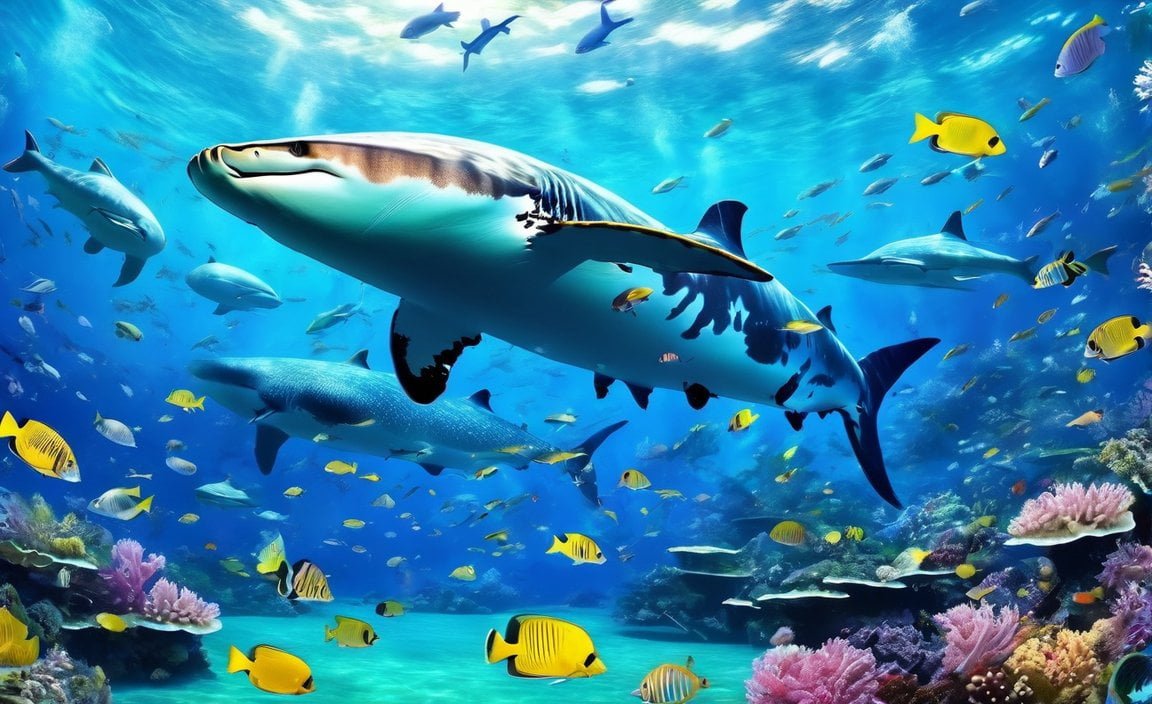
FAQ
Q1: How many species of animals live in the ocean?
A1: There are about one million species of animals living in the ocean, with the majority being invertebrates.
Q2: Which underwater animal is the largest?
A2: The blue whale is the largest ocean animal.
Q3: How far can whale songs be heard in the ocean?
A3: Whale songs can be heard for hundreds of miles in the ocean.
Q4: Do all bony fish have more than one set of nostrils?
A4: Many bony fish have more than one set of nostrils.
Q5: How many hearts do octopuses have?
A5: Octopuses have three hearts.
